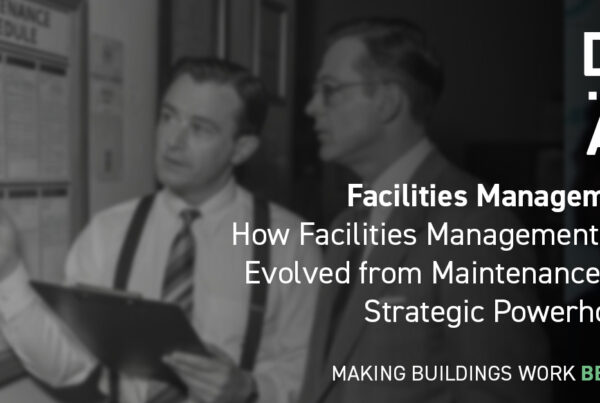
The UK Government’s Facilities Management Strategy and What it Means for Facilities Managers in 2025.
The government’s UK Facilities Management Strategy has been introduced focusing on improvements in sustainability, compliance, efficiency and the integration of technology into FM practice. While this specifically affects the public sector, these changes will also influence private sector industry trends.
The UK Facilities Management Strategy is guided by the Government Property Function, which manages the biggest, most diverse property estate in the country, operating across departments, delivery organisations and agencies covering more than 140,000 properties with a combined value of more than £180bn.
This blog will explore the key goals and requirements of the strategy and what FMs must do now to deliver these aims by 2030 – the timeframe set for implementation.
More information can be found by reading the UK Government’s full overview.
Introducing the Three Pillars of the UK Facilities Management Strategy
To achieve the Government’s ambitious 2030 targets, the UK Facilities Management Strategy is structured around three core pillars. Each pillar addresses a critical area of focus designed to raise standards, enhance efficiency, and ensure facilities management delivers greater value to users, organisations, and wider society.
These pillars set clear expectations for facilities managers, service providers, and organisations alike, offering a structured pathway towards more sustainable, technology-driven, and user-focused FM services.
Let’s explore each of the three pillars in detail:
Pillar One: Making every experience in buildings a positive one
The UK Government’s buildings are used by a wide number of the public. These include children, public servants, and patients in hospitals. This means that facilities managers (FMs) working within the public sector must also be aware of the accessibility of everyone who uses these buildings, ensuring productivity and safety.
Goal A – Frontline delivery for accessible and responsive spaces
2030 ambition: Ensure facilities management (FM) services are equipped to respond to changing service delivery models, informed by user experience data.
What the Government Property Function will do by the end of this year:
- Develop and maintain organisational five-year FM strategies aligned with the Government Property Strategy.
- Implement organisational plans for influencing users’ behaviours within a facility, in order to create a positive response to the environment, the organisation and other stakeholders.
- Create a management system for FM, modelled on a recognised standard, for all their FM activities
Measure: An annual monitor through the organisational Strategic Asset Management Plan (SAMP).
What this means for FMs
- FMs will need to adapt services to suit dynamic ways of working, such as hybrid WFH models.
- User experience data (e.g., feedback, surveys, occupancy trends) will be increasingly important in shaping how services are delivered. Facilities managers will use this data to inform better decision making.
- User behaviour needs to be proactively shaped, through layout, signage, design, and services to encourage respectful, sustainable, and productive use of facilities.
- A standardised management system (like ISO 41001) is expected to ensure consistency, accountability, and best practice across all FM operations.
- Strategic thinking and reporting will be essential for effective reporting.
- Thinking beyond core FM functions to how these services can integrate with other roles to shape the overall experience.
Goal B – Flexible and inclusive facilities management services in supportive workplaces
2030 ambition: FM organisations across the Government will be certified to the Cabinet Office Customer Service Excellence quality mark.
What the Government Property Function will do by the end of this year:
- Adopt existing government FM standards FMS 001 and FMS 002.
- Ensure FM teams and suppliers adopt a one team approach to the delivery of FM services, promoting a seamless user experience.
- Check all FM procurements fully explore regionally based supply chains and SME options, supporting the government’s levelling up scheme.
Measure: Using the maturity tools that form part of SAMPs. This includes monitoring the progress of formal accreditation and certification of FMs to the Cabinet Office Customer Service Excellence Standard.
What this means for FMs
- If you haven’t already, you’ll need to adopt frameworks FMS 001 and FMS 002, which set out best practice.
- Actively consider local suppliers and SMEs to support regional growth and the Government’s levelling up agenda.
- Adopt a ‘one team’ approach to provide a seamless experience across multiple building users.
Goal C – Sustainability at the forefront of all facilities management activities
2030 Ambition: Government organisations will measure all carbon emissions related to their FM supply chains. They’ll also produce regular management information to feed into wider organisational net zero reporting.
What the Government Property Function will do by the end of this year:
- Develop a sustainability plan for their FM activities and produce regular management information to feed into wider organisational sustainability reporting.
- Maintain a net zero strategy and action plan for their FM activities and produce regular management information to feed into wider organisational net zero reporting.
- Ensure carbon reduction plans are incorporated into the procurement of all major FM contracts.
Measure: FM Control criteria assessments in addition to inclusion in organisational SAMPS.
What this means for FMs
- FMs will need to develop and maintain detailed carbon reduction strategies to meet contract requirements.
- Resource and incorporate green technologies, such as energy-efficient systems and renewable energy solutions. This can include LED lighting upgrades, smart building systems, low-carbon heating solutions, and onsite renewable energy like solar panels.
- Ensure compliance with sustainability reporting obligations.
- Consider the emissions of future refurbishments or replacements. This is known as whole life carbon thinking.
- Audit all members of the supply chain for the sustainable effectiveness.
Our work with Rye, Winchelsea and District Memorial Hospital, the UK’s first net zero community hospital, demonstrates best practice for implementing a sustainability and carbon reduction strategy. Read how we did it, here.
Pillar Two: FMs must deliver professionally and seamlessly
FM professionals make up a significant number of Government Property Professionals. 25% of these have over 20 years of experience.
It’s clear that there’s a need to disseminate this knowledge gets shared across teams. No matter where service users are in the public sector, they expect the same level of standard. To ensure consistency, the Government Property Function must provide clear job roles for each department, as well as recruit and train the future FM professionals to carry out the work.
Goal A: Facilities management professionals equipped with effective skills and capabilities
2030 ambition: 90% of FM, Workplace and Maintenance Senior Practitioners and Leaders are accredited or working towards accreditation with an approved property professional body.
There will also be a dedicated government-wide FM resource hub.
What the Government Property Function will do by the end of this year:
- Ensure 75% of people in FM, Workplace and Maintenance Senior Practitioner and Leader roles are accredited or working towards accreditation with an approved property professional body.
- Ensure 75% of people in FM, Workplace and Maintenance roles will hold an appropriate level of membership of an approved professional body.
- Ensure 5% of FM, Workplace and Maintenance roles across government will be apprentices or Fast Stream.
- Establish a forum for the collaboration of FM specialists across government focused on the delivery of effective FM services.
- Build on the existing career pathways by supporting FM professionals with tailored learning and development.
- Introduce an FM secondment programme.
Measure: The number of FM professionals within the Government Property Profession with professional accreditation. In addition, the number of FM apprentices and Fast Streamers working with FM teams.
What this means for FMs
- Check that your leaders hold or are working towards accreditation from a professional body, such as IWFM, RICS or BIFM.
- Engage with continuing professional development and ensure you are offering structured career pathways and training.
- Confirm that the training offered is accessible to various learning styles and neurodiverse people.
- Ensure that you make positions available for apprentices and offer mentoring if possible. Information on offering apprenticeships, can be found here.
- Develop a secondment programme within your organisation if you haven’t already.
- Take advantage of an FM forum to share best practice.
Goal B: Effective standards, tools, technology and organisation
2030 ambition: FM services and contracts have the agility, flexibility and leadership to anticipate and respond to innovations in the workplace. The maturity standard of “Good” is to be achieved by all government organisations.
What the Government Property Function will do by the end of this year:
- Build on the existing FM standards and policy to maintain a suite of standards for the delivery of FM across government.
- Develop a roadmap to maturity relating to the FM standards to drive up quality.
- Promote and flex within contracts the use of technology for data aggregation from users and building systems to provide feedback on actual user experience and building performance.
- Develop a playbook of FM delivery activities along with associated resourcing guidelines.
Measure: Publication of an FM Playbook and the establishment of a forum for FM collaboration. They’ll also assess the number of organisations meeting the maturity standard of “Good”.
What this means for FMs:
- Working within a consistent set of FM standards that are designed for clarity, consistency, and professionalism.
- Actively raise the maturity of your FM service – through operational delivery and performance management.
- Using smart technology as much as possible, such as our dedicated platform BiO®.
- Focusing on a predictive approach to maintenance.
- Sharing, and learning from, best practice with other FMs in the public sector.
Goal C: Metrics that measure real world performance
2030 ambition: To have the specialist capability to analyse FM outcomes and spend across government to promote and embed innovation, the adoption of best practice and evidence-supported investment.
What the Government Property Function will do by the end of this year:
- Establish and implement common metrics and standards for user experience, embedding maturity measurements and targets within SAMPs.
- Create common metrics and standards for compliance and maintenance spending.
Measure: Publication of further FM standards and implementation of consistent cross-government metrics.
What this means for FMs:
- SAMPs will need to include targets linked to user satisfaction, service delivery outcomes, and cost effectiveness.
- Ensuring data-literacy in your approach.
- Using data effectively to identify potential operational improvements or cost efficiencies.
- There may be more scrutiny on investment decisions, so bookkeeping must be kept up to date.
Pillar Three: FMs must demonstrate value to all stakeholders and society
Stakeholders are always seeking a return on their investments. To demonstrate value, asset data registers and a whole of life cost approach are critical. The Government Functional Standard for Property 004 states that FMs must carry out regular condition audits of their assets. Knowing the condition of the assets makes strong business cases when applying for the funding for repairs.
One of DMA’s key services is helping client with their asset registers. With our integrated managed services solution and service management platform BiO®, we keep track of assets and staff as part of a predictive approach to maintenance, supporting right first time works and reduced downtime.
Goal A: A holistic approach to FM asset management
2030 ambition: A whole life asset management approach will be taken for all investments in FM asset maintenance and replacement. Driving a reduction in backlog maintenance whilst supporting organisational estate strategies to consider the overall size of their estates and how best to raise the quality.
What the Government Property Function will do by the end of this year:
- Ensure all buildings have a condition survey and a costed rolling five-year minimum forward maintenance register.
- Ensure all buildings have a 30-year lifecycle replacement profile.
- Develop and maintain a rolling three-year lifecycle building maintenance and investment plan informed by strategic asset management plans.
- Assure compliance with the condition survey requirements of standard 004.
- Publish a Whole Life Asset Management toolkit to support the effective management of property assets across government.
Measure: The number of poor condition buildings will be measured and monitored through SAMPs.
What this means for FMs:
- Every applicable building you manage will need to have a comprehensive survey.
- Prepare a five-year maintenance plan if you haven’t already.
- Keep a 30-year lifecycle placement profile for all major assets (e.g. HVAC systems, lifts)
- Review Standard 004 and ensure you comply.
- The government will supply a Whole Life Asset Management toolkit.
Goal B: Standardised and assured FM data and analysis
2030 ambition: FM teams and suppliers will have confidence in the accuracy and completeness of FM data, while having the capability and capacity to use it to support service.
What the Government Property Function will do by the end of this year:
- Ensure each government organisation has a named individual responsible for FM data.
- Confirm all buildings have an FM asset register compliant with Government FM Standard FMS 002 Asset Data.
- Ensure that all FM roles require a GPP career framework analytical decision-making technical skill level of Working, with Practitioner for FM Practitioner and Senior Practitioner roles.
- Make sure all government organisations have in-house Expert level analytical decision-making FM capability as appropriate.
Measure: Compliance with the FM Asset Data Standard will be monitored using the appropriate maturity tools. The number of FM people with GPP career framework analytical decision-making technical skill levels of Working and Practitioner.
What this means for FMs:
- If you’re in a senior role, there’s a strong change you’ll be responsible for data or work with someone who is. Become familiar with data accuracy and accessibility to ensure there aren’t any surprises.
- Maintain an up-to-date asset register. This will be routinely monitored for quality and completeness.
Goal C: Assured FM Contracts delivering quality services
2030 Ambition: FM contract arrangements will be value based and structured to contribute to the levelling up and provide social value to the communities throughout the UK.
What the Government Property Function will do by the end of this year:
- Maintain a pipeline of all government FM contracts, shared across the government to encourage, joint contracting, location / regionally based service provision and use of SMEs.
- Bring all central government FM contracts within the FM Control scope by the end of 2025.
- Broaden and deepen engagement across the whole FM market, building on existing relationships with strategic suppliers.
- Establish consistent specifications for supplier and contractor job roles and qualifications.
Measure: Quality and complete FM contract pipelines in place across all in scope organisations.
What this means for FMs:
- Job roles may become more standardised across government.
- Work with local suppliers that have a strong social value and prioritise government initiatives like levelling up.
- Take a strategic approach to procurement.
2030 and beyond
As the Government’s FM ambitions continue to evolve, roles are becoming more strategic, data-driven, and outcome-focused. This is essential if we are to hit the targets set for 2050. Tools such as BiO® can support FMs in these aims, streamlining workflows, tracking assets and people, and effectively analysing and understanding data.
At DMA, we understand the pressures facilities managers face and we’re here to help. Whether you’re navigating net zero targets, preparing for contract reform, or aligning with Government Standards, our expert team can support you at every stage.




